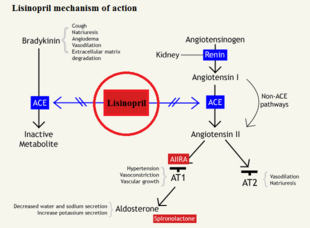Prinivil/Sandbox 1
From Proteopedia
Contents |
Lisinopril
|
TEMP=Green links for structure
TEMP=Needs Editing
[1]Lisinopril was patented by Merck & Co. under the brand name of Prinivil.[2] Lisinopril functions as a competitive inhibitor of the angiotensin converting enzyme (ACE). ACE cleaves specific residues of an inactive angiotensin 1 near the C domain (domain closer to the C-terminus) to form a potent vasopressor octapeptide known as angiotensin 2; however, the specific substrate binding and catalysis is not fully understood. ACE is found as a type 1 membrane bound dipeptidyl carboxypeptidase that regulates blood pressure and steady state equilibrium of ions within the blood. Located on vascular epithelial cells, the drug interaction takes place on the surface of the cell within an artery/vein.[3]. The ligand is stabilized by 3 residues (2 histidines (RES #) and 1 glutamic acid (RES #)) We need to add the specific residue bindings here at some point interacting through hydrogen bonding along with an ionic binding of a Zinc atom and the carboxylate group which configures the molecule in 3D space.
To-do:
- Patent date
- More information on clinical trials maybe (?)
- Make sure everything is well-defined and linked for easy understanding.
Function
Bradykinin is a common vasodilator that, when bound to ACE, will allow ACE the cleave angiotensin I to angiotensin II, but when bound to lisinopril, bradykinin levels rise in the blood stream causing a decrease in blood pressure and increased vasodilation. As seen in Figure 1, bradykinin will bind to the ACE, which allows for the conversion of angiotensin I to angiotensin II by the ACE/bradykinin complex. By blocking the active site of ACE, an inactive angiotensin 1 cannot be cleaved, which would block the cascade of events triggered by angiotensin 2 binding to type 1 AT2 receptor to create vasoconstriction.To-do:
- other common and relevant ACE inhibitor drugs
- What are diseases in humans that can be helped by lisinopril or affect lisinopril inhibition efficiency.
- More detail on mechanism. Needs more
- Figure out how to use wiki markup in captions of thumbnails if possible (?)
Structure
To-do:
- General Information on mass, conformations, stereochemistry, etc.
- Common source of Zn in ACE
- Include Green links for structure viewing of various ACE sites and relevant molecules
- Create structures for viewing
Mechanism
ACE Active site has a NH3+ group which binds to the COOH terminus of the drug. NH of the enzyme binds to the middle C=O group of the drug. The benzene ring of the drug fits into a hydrophobic pocket(S1) of the enzyme. The 5-membered nitrogenous ring of the drug fits to the S2’ pocket. The lysine segment fits into the S1’ pocket.
To-do:
- all relevant, interacting residues described
- known mechanistic theories
- Figure out how to make multiple footnotes referencing the same paper.
References
- ↑ Canner, D. Lisinopril http://proteopedia.org/wiki/index.php/prinivil (accessed Nov 10, 2016).
- ↑ PRINIVIL® (lisinopril) https://www.merck.com/product/usa/pi_circulars/p/prinivil/prinivil_pi.pdf (accessed Nov 16, 2016).
- ↑ Natesh R, Schwager SL, Sturrock ED, Acharya KR. Crystal structure of the human angiotensin-converting enzyme-lisinopril complex. Nature. 2003 Jan 30;421(6922):551-4. Epub 2003 Jan 19. PMID:12540854 doi:http://dx.doi.org/10.1038/nature01370
- ↑ Akif M, Georgiadis D, Mahajan A, Dive V, Sturrock ED, Isaac RE, Acharya KR. High-resolution crystal structures of Drosophila melanogaster angiotensin-converting enzyme in complex with novel inhibitors and antihypertensive drugs. J Mol Biol. 2010 Jul 16;400(3):502-17. Epub 2010 May 19. PMID:20488190 doi:10.1016/j.jmb.2010.05.024
- ↑ Hanson, R. M., Prilusky, J., Renjian, Z., Nakane, T. and Sussman, J. L. (2013), JSmol and the Next-Generation Web-Based Representation of 3D Molecular Structure as Applied to Proteopedia. Isr. J. Chem., 53:207-216. doi:http://dx.doi.org/10.1002/ijch.201300024
- ↑ Herraez A. Biomolecules in the computer: Jmol to the rescue. Biochem Mol Biol Educ. 2006 Jul;34(4):255-61. doi: 10.1002/bmb.2006.494034042644. PMID:21638687 doi:10.1002/bmb.2006.494034042644
- ↑ Wang X, Wu S, Xu D, Xie D, Guo H. Inhibitor and substrate binding by angiotensin-converting enzyme: quantum mechanical/molecular mechanical molecular dynamics studies. J Chem Inf Model. 2011 May 23;51(5):1074-82. doi: 10.1021/ci200083f. Epub 2011, Apr 26. PMID:21520937 doi:http://dx.doi.org/10.1021/ci200083f

